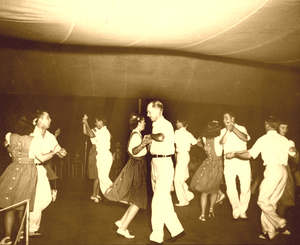
Back Square dance Afrikaans Square Dance ALS رقص رباعي Arabic Square dance (dansa) Catalan Square dance Czech Square dance Danish Square Dance German Square dance Spanish Square-tanssi Finnish Square dance French
This article has multiple issues. Please help improve it or discuss these issues on the talk page. (Learn how and when to remove these messages)
|

A square dance is a dance for four couples, or eight dancers in total, arranged in a square, with one couple on each side, facing the middle of the square. Square dances are part of a broad spectrum of dances known by various names: country dances, traditional dances, folk dances, barn dances, ceilidh dances, contra dances, Playford dances, etc. These dances appear in over 100 different formations,[1] of which the Square and the Longways Set are by far the most popular formations.
Square dances contain elements from numerous traditional dances including English country dances, which were first documented in 17th-century England, and 18th-century French quadrilles and cotillions;[2] square dancing travelled to North America with the European settlers and developed significantly there.
Square dancing is done in many different styles all around the world.[3] In some countries and regions, through preservation and repetition, square dances have attained the status of a folk dance. Square dancing is strongly associated with the United States, in part due to its association with the romanticized image of the American cowboy in the 20th century,[4] and 31 states have designated it as their official state dance.[5] The main North American types of square dances include traditional square dance and modern western square dance, which is widely known and danced worldwide. Other main types popular in England, Ireland, and Scotland include Playford dances, regional folk dances, ceili, Irish set dances, and Scottish country dances.
The couples in a square are numbered, although numbering varies among different types. In many of the types, two of the couples are known as heads and the other two are called sides. In most American forms of square dance, the dancers are prompted or cued through a sequence of steps by a caller to the beat (and, in some traditions, the phrasing) of music. In other variations, dancers have no caller and instead memorize and perform a specific routine and sequence of steps. Square dance music varies widely, with some forms using traditional tunes and others employing more modern types.
Dances can be organized by square dance clubs, bands, individuals, or similar organizations. Attire varies by type, with some forms possessing a specific dress code and others having no requirements. The standard square formation can also vary at times to include more or fewer dancers or arrange dancers in a different shape.
- ^ "Country Dance & Contra Dance 100+ Formations".
- ^ "All About Square Dance: A Brief History of Square Dance". MasterClass. 2021-07-21. Retrieved 2023-04-30.
- ^ "Square Dancing History - Across 400 Years & Around the World".
- ^ Cite error: The named reference
:2was invoked but never defined (see the help page). - ^ Blakemore, Erin (2017-06-16). "The Slave Roots of Square Dancing". JSTOR Daily. Retrieved 2020-10-16.